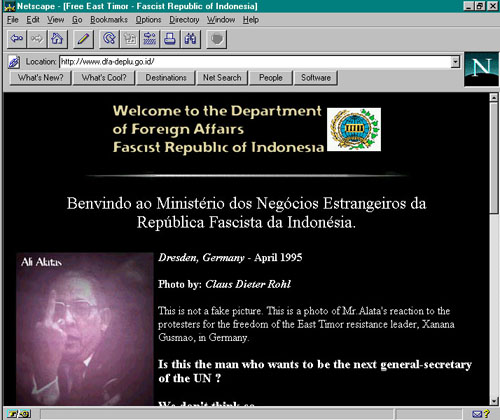Portuguese-Indonesian Cyber Incidents
Historical cyber conflicts between Portuguese hackers and Indonesian institutions (1995-2002)
Historical
1995-2002
Hacktivism
Early Digital Protests
April 1995

Historical Screenshot - April 1995
One of the earliest documented cases of Portuguese hacktivism targeting Indonesian government websites occurred in April 1995. Hackers defaced the Department of Foreign Affairs website, renaming it to "Fascist Republic of Indonesia" and including messages in Portuguese supporting East Timorese independence.
Key Details
- Target: Indonesian Department of Foreign Affairs (dfa.go.id)
- Platform: Early web (Netscape Navigator era)
- Content: Bilingual protest messages (English and Portuguese)
- Documentation: Photo credited to Claas Dieter Rohl, Dresden
- Historical Context: Early example of hacktivism for East Timor
Campaign Timeline
April 1995
Early Protests and Digital Activism
Documentation of early digital protests against Indonesian control of East Timor
December 23, 1996
BPPT Website Attack
Portuguese Hackers Against Indonesia Tiranny (PHAIT) conducted a mass hack against BPPT's website
1997
Campaign Intensifies
Multiple Indonesian government websites targeted by Portuguese hackers
2002
Official Documentation
Indonesian National Police documents the attacks in cybercrime investigation training materials
PHAIT Campaign
Following these early protests, the movement evolved into more organized campaigns. The most notable was the formation of PHAIT (Portuguese Hackers Against Indonesia Tiranny) in 1996, which conducted systematic attacks against Indonesian government infrastructure.
- Coordinated attacks against multiple government websites
- Clear political messaging supporting East Timorese independence
- Use of defacement as a protest tool
- International media attention to the cause
- Documentation in official Indonesian cybersecurity records
Technical Evolution
Early Methods (1995)
- Basic website defacement
- Static content replacement
- Simple HTML modifications
- Limited technical sophistication
Later Techniques (1996-2002)
- Coordinated mass attacks
- More sophisticated penetration methods
- Organized group operations
- Improved persistence and impact